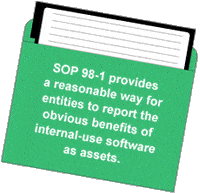SOP 98
SOP 98
Term Definition of SOP 98 SOP 98-1 is a Statement of Position, Accounting for the Costs of Computer Software Developed or Obtained for Internal Use, issued by the American Institute of Certified Public Accountants. SOP 98 provides guidance on the capitalization of software created for internal use. The SOP 98 applies to all non-government entities […]
Term Definition of SOP 98
SOP 98-1 is a Statement of Position, Accounting for the Costs of Computer Software Developed or Obtained for Internal Use, issued by the American Institute of Certified Public Accountants. SOP 98 provides guidance on the capitalization of software created for internal use. The SOP 98 applies to all non-government entities and must be adopted for fiscal years beginning after December 15, 1998.
SOP 98-1 describes the allocation of project time and expenses as an operating expense or to asset categories that can be capitalized. The main parameters of the guidance are that planning and initial selections of alternatives are expensed as incurred. After the planning has been completed and coding has begun, these costs may be capitalized (including internal labor–only those working directly on the project). Work performed by external consultants may also be capitalized. Capitalization stops when the project is ready for its intended use. Training end-users and maintenance costs are expensed as incurred.
 What does SOP 98 do?
What does SOP 98 do?
SOP 98-1 defines three phases to projects, a preliminary phase of assessment and planning, the development phase of actual design, installation and testing, and finally the post implementation and operation phase, where the internal software is deployed and adopted through the organization. While internal and external costs accrued during the first and third stages must be expensed against current operation, SOP 98-1 allows the costs involved in the development phase to be capitalized.
SOP 98-1 does not allow general and administrative costs (or overhead expenses) to be included in the capitalized cost of the internal project, a restriction, which can make time reporting problematic. Thus, organizations must be able to define capitalized cost hours not only by project and task but activity and description. A timesheet and expense reporting system can be used to track all project costs and mark phases of the project as operating expenses or capitalized costs.
The use of software does not guarantee compliance but can substantially automate the project governance and compliance process. Utilizing time and billing software can simplify the tracking of applicable SOP 98 items.
